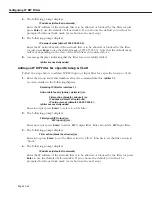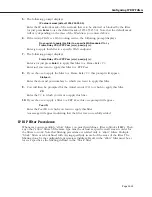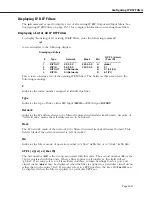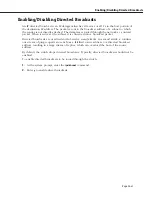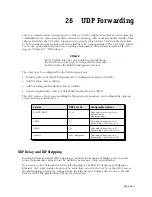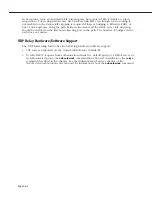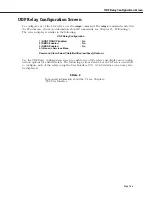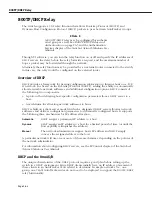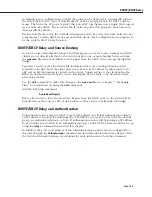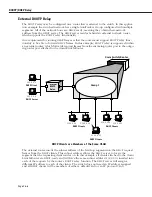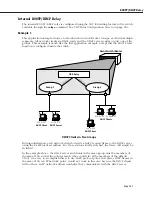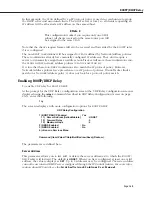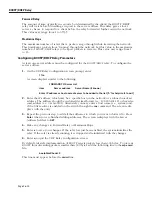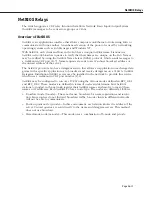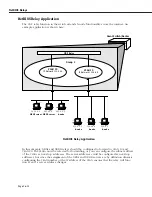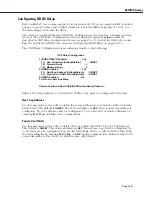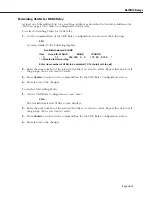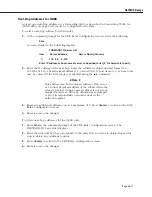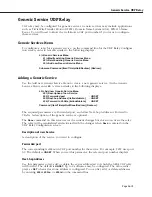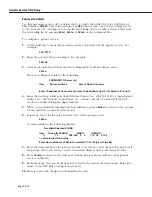
BOOTP/DHCP Relay
Page 26-5
In multiple group configurations, AutoTracker rules can be deployed to strategically support
the relay function. Two types of AutoTracker IP policies are appropriate for
DHCP
environ-
ments. The first is the IP protocol policy that puts all IP type frames into a single
VLAN
regard-
less of network address. The second is the
IP
network policy that groups
IP
users based on
their specific IP address.
Besides AutoTracker rules, the network administrator must be aware that some network envi-
ronments may contain
DHCP-
ready and non-
DHCP
clients. Such configurations are supported
by the switch’s
BOOTP
relay function.
BOOTP/DHCP Relay and Source Routing
In source route environments (where
VLAN
framing type is set for source routing) and
DHCP
clients are not directly attached to the switch but have one or more bridges between them,
the
mpx.cmd
file must be modified so that replies from the
DHCP
server can get through the
bridge.
Typically a router caches the client’s
RIF
information for source routing when the client
responds to an
ARP
, but if the client does not yet know its
IP
address it cannot reply to an
ARP
and no
RIF
information is cached on the router. Unicast replies to the client before the
RIF is cached are discarded by the router. Forcing the
BOOTP
reply to be broadcast elimi-
nates this problem.
Use the
edit
command to make this change to the
mpx.cmd
file (see Chapter 7, “Managing
Files,” for instructions on using the
edit
command).
Add the following command:
bootpBcastReply=1
Reboot the switch to force the broadcast. Replies from the
DHCP
server to the client will be
broadcast from the router as
STE
or
ARE
packets so they can be sent through the bridge.
BOOTP/DHCP Relay and Authentication
Authentication clients may use
DHCP
to get an IP address. For Telnet authentication clients,
an IP address is required for authentication. The DHCP server may be located in the default
group, an authenticated group, or both. If authentication clients will be getting an IP address
from a
DHCP
server located in an authenticated group, a
BOOTP
/
DHCP
relay should be set up
using the
relayc
command described in this chapter.
In addition, the router port address of the authenticated group must also be configured for
the relay through the
avlbootpmode
command. See the Authentication Services chapter of the
the
Switched Network Solutions User Manual
for more information about this command.
Summary of Contents for Omni Switch/Router
Page 1: ...Part No 060166 10 Rev C March 2005 Omni Switch Router User Manual Release 4 5 www alcatel com ...
Page 4: ...page iv ...
Page 110: ...WAN Modules Page 3 40 ...
Page 156: ...UI Table Filtering Using Search and Filter Commands Page 4 46 ...
Page 164: ...Using ZMODEM Page 5 8 ...
Page 186: ...Displaying and Setting the Swap State Page 6 22 ...
Page 202: ...Creating a New File System Page 7 16 ...
Page 270: ...Displaying Secure Access Entries in the MPM Log Page 10 14 ...
Page 430: ...OmniChannel Page 15 16 ...
Page 496: ...Configuring Source Route to Transparent Bridging Page 17 48 ...
Page 542: ...Dissimilar LAN Switching Capabilities Page 18 46 ...
Page 646: ...Application Example DHCP Policies Page 20 30 ...
Page 660: ...GMAP Page 21 14 ...
Page 710: ...Viewing the Virtual Interface of Multicast VLANs Page 23 16 ...
Page 722: ...Application Example 5 Page 24 12 ...
Page 788: ...Viewing UDP Relay Statistics Page 26 24 ...
Page 872: ...The WAN Port Software Menu Page 28 46 ...
Page 960: ...Deleting a PPP Entity Page 30 22 ...
Page 978: ...Displaying Link Status Page 31 18 ...
Page 988: ...Displaying ISDN Configuration Entry Status Page 32 10 ...
Page 1024: ...Backup Services Commands Page 34 14 ...
Page 1062: ...Diagnostic Test Cable Schematics Page 36 24 ...
Page 1072: ...Configuring a Switch with an MPX Page A 10 ...
Page 1086: ...Page B 14 ...
Page 1100: ...Page I 14 Index ...


